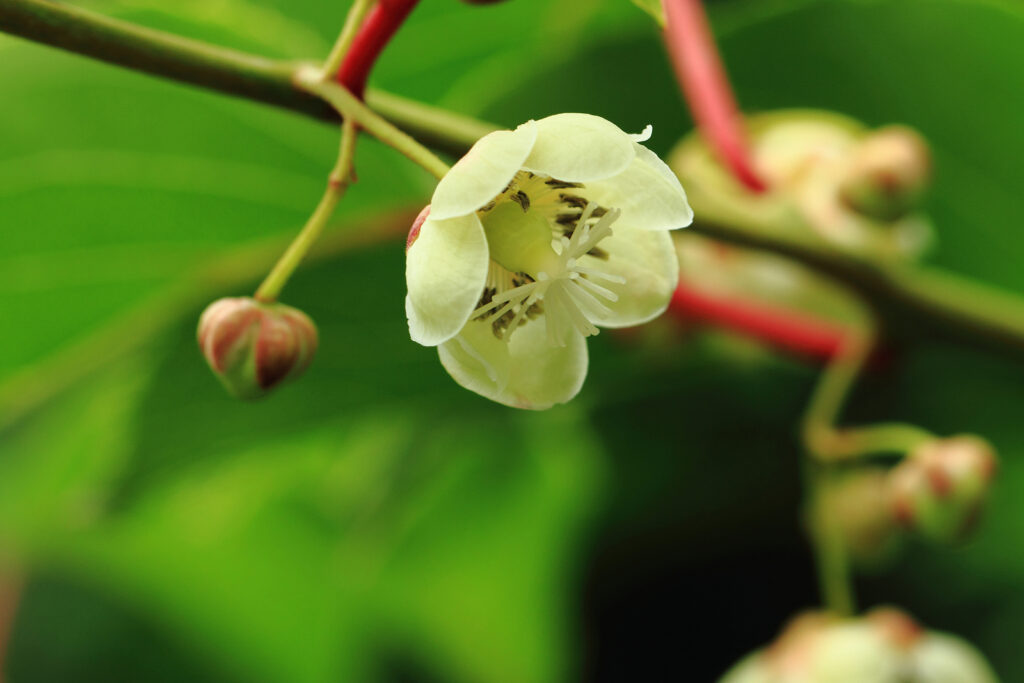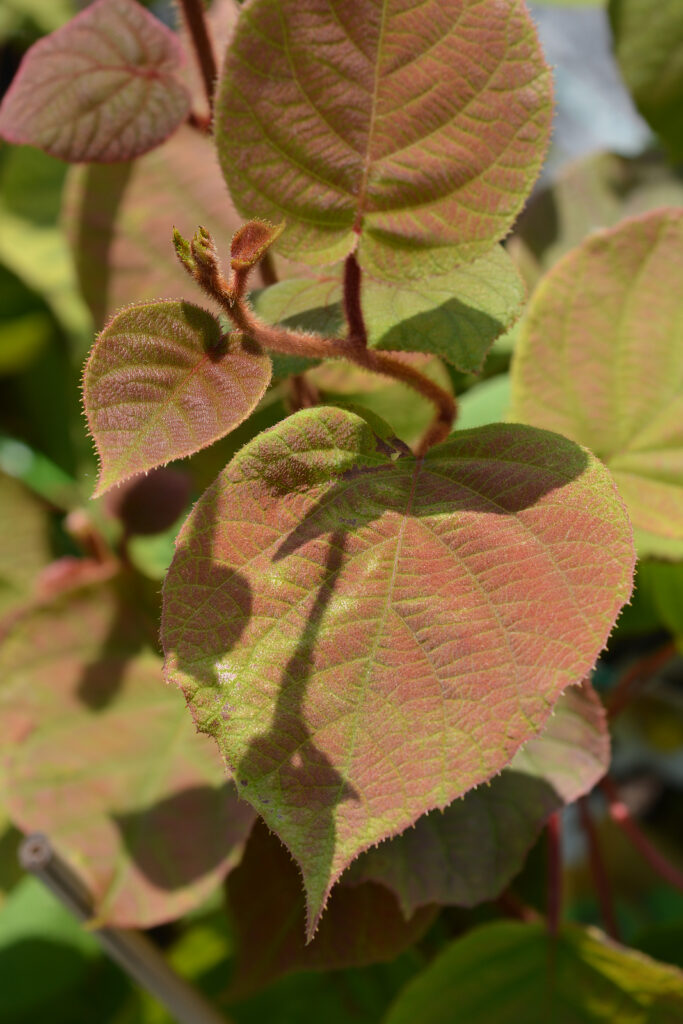Actinidia — commonly called Kiwi–are woody twining vines that produce small, cup-shaped flowers in summer followed by many-seeded edible berries. Actinidia need supports to twine upon–a trellis, arbor, or pergola. They can be trained to cover walls and fences.
Kiwi fruit is borne on shoots from year-old wood or older; to keep the plant productive, cut out shoots that have fruited for three years and shorter young shoots, leaving three to seven buds beyond the previous summer’s fruit.
There are about 40 species of Actinidia. Actinidia are native to forests in East Asia. The most tender species bear large fruits, hardy species bear grape-sized fruits, one species is grown for its colorful foliage.

Get to know Actinidia
- Plant type: Deciduous vines
- Growing zones and range: Zones 4 to 9
- Hardiness: Hardy to Zone 4
- Height and width: 20 feet (6.1m)
- Growth rate: Moderate
- Form and habit: Wooding, twining vines
- Foliage: Bright leaves open purple and then mature to green splashed with pink and white variegation; coloration is strongest in direct sunlight; male vines have the brightest colors, and mature plants tend to be more colorful than young vines
- Flowers: Small cup-shaped white blooms, not showy but fragrant; blooms borne singly or in small clusters
- Fruits: Female vines produce edible many-seeded berries that attract birds in fall; you must grow both male and female to bear fruit
- Bloom time: Early summer
- Uses: Garden backdrop, archways, fences, trellises, or as screens or privacy barriers
- Garden companions: Purple leaved plants, such as purpleleaf sand cherry or ‘Forest Pansy’ redbud
- Common name: Kiwi
- Botanical name: Actinidia
- Family name: Atinidiaceae
- Origin: Eastern Asia
Where to plant Actinidia
- Plant Actinidia in full sun or partial shade; colors best in full sun.
- Plant Actinidia in average to rich, well-drained fertile soil.

When to plant Actinidia
- Set Actinidia in the garden in spring and autumn.
Planting and spacing Actinidia
- For fruit production, grow one male Actinidia for every few females, or plant a self-fertile cultivar.
How to water and feed Actinidia
- Keep Actinidia continuously moist.
- Feed Actinidia with an all-purpose organic fertilizer in spring, but not to excess; colors fade with too much fertilizer.
How to care for Actinidia
- Actinidia are large, vigorous plants that require a sturdy trellis or arbore for support before planting.
- Train Actinidia to cover an arch or arbor as an entrance to a garden; the foliage is beautiful when matched with purple and rust tones such as brick.
- Consider painting its supporting structure purple.
- Prune Actinidia continually in late winter or early spring to keep them in bounds.
- For fruit production, use a pruning and training system designed for grapes.
- Shape Actinidia to one or two main trunks; cut out closely parallel or crossing branches. Fruit is borne on shoots from year-old or older wood; cut out shoots that have fruited for 3 years and shorten younger shoots, leaving from three to seven buds beyond previous summer’s fruit. In summer, shorten overlong shoots and unwind shoots that twine around main branches.
- In areas colder than zone 6, Actinidia dies down to the ground each winter.
Actinidia pests and diseases
- Actinidia have few pest problems.
Actinidia propagation
- Propagate Actinidia by taking cuttings in summer; bottom heat speeds rooting.
- Sow seed in containers in a cold frame in autumn and spring.

Actinidia varieties to grow
- Actinidia arguta, Hardy kiwi, Tara vine, a woody, deciduous climber reached 20 feet (6.1m) or more in height. Bears dark green, 5 inch (12.7cm) long, toothed leaves. Small clusters of fragrant, .8 inch (2cm) wide, white flowers appear in early summer. Flowers are followed by smooth-skinned, yellow-green, 1 inch (2.5cm) long fruits on female plants. ‘Issai’ is a self-fertile cultivar that bears fruit without male and female plants. Zones 3 to 8.
- A deliciosa (A. chinensis), Kiwi fruit, Chinese gooseberry, this vigorous, woody, deciduous vine climbs to 30 feet (9.1m) Plants bear heart-shaped, 8 inch (20.3cm) long leaves and stems that are covered with red-brown hairs. Small clusters of 1.5 inch (3.8cm) wide creamy white flowers that fade to yellow appear in early summer. On female plants flowers are followed by 3 inch (7.6cm) long green-brown fruits covered with bristly brown hairs. Names male and female cultivars are available. Zones 7 to 9.
- A kolomikta, Variegated kiwi vine, a woody deciduous vine that grows to 15 feet (4.6m) and bears rounded, 6 inch (15.2cm) long leaves. When leaves emerge they are green with a purple tinge. As they mature, showy white and pink blotches develop toward the tips of the leaves. In early summer, plants produce small clusters of fragrant, white, .8 inch (2cm) wide flowers. On female plants, flowers are followed by smooth-skinned, 1 inch (2.5cm) long, yellow-green berries. ‘Arctic beauty’, hardy in Zones 4 to 8, has purple-tinged leaves that become variegated with purple, pink, and green as they mature. Zones 5 to 8.















